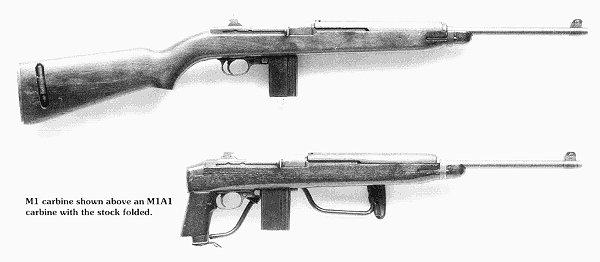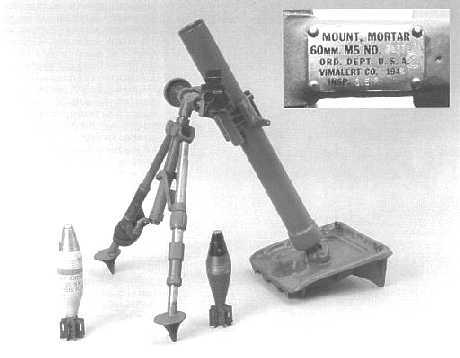|
|
Weapons
|
M-1 Garand
|
 |
Operation:
Semiautomatic, Gas Operated
Caliber: .30 (.30-06)
Length: 43.6 in. (1103 mm)
Weight unloaded: 9 lb 8 oz (4.37 kg)
Barrel: 24 in. 4 grooves, right hand twist
Magazine: 8 round internal box, clip loaded, clip ejected after
last round fired
Muzzle velocity: 2800 fps, 2903 ft-lb
500 yds: 1918 fps, 1362 ft-lbs
Ammunition: 174 gr bullet, 50 gr charge, Ball M1
Effective Range: 440 yds
Classification: "Standard" from 1936
Total production: Approx. 4,040,000
The M1 Garand is a full blown
combat rifle with maximum range of 3,200 meters and maximum effective
range of 400 meters, or the greatest distance at which the weapon
can be expected to fire accurately to inflict casualties or damage.
Fully loaded with 8-round en bloc clip, cleaning kit in butt stock,
sling and with stock of dense GI issue wood the M1 weighed in
at 11-1/4 lbs. The M1 came into production in 1936 using the .30-06-rifle
cartridge. The M1 was the designated service rifle of World War
II for the United States Military. It was designed for semi-automatic
fire using a spring steel clip containing 8 rounds. This is where
the term "clip" originated. All other rifles used a
detachable or fixed magazine. (There is some discussion on whether
this is accurate, if you have a comment, please enter it on our
Bulletin Board.) The M1 Garand was designed for long range accuracy
i.e. battle zero was set for any target less than 200 yards It
was the only rifle that had fully adjustable i.e. windage and
elevation, rear sights. The M1C, manufactured by Springfield Armory
in late
1944-1945, mounted an M81 or M82 scope, a T4 leather cheek pad,
and an M2 flash hider. The The original rear sight of the M1 would
not hold adjustments very well, so a locking bar was added in
late 1942 which could be tightened after sights were set.
|
| |
|
M-1 & M1A1 Carbine
|
 |
Operation:
M1, M1A1 Semiautomatic; M2 Selective
Length: 35.65 in. (905 mm)
Weight unloaded: 5 lb 7 oz (2.48 kg)
Barrel: 18 in. 4 grooves, right hand twist
Magazine: 15 or 30 round detachable box
Muzzle velocity: 1990 fps, 967 ft-lbs.
Rate of Fire: M2 on full auto, 650-700rpm
300 yds: 1035 fps, 262 ft-lbs
Ammunition: 108 gr bullet, 13 gr charge, US Service M1
Effective Range: 300 yds
The M1 Garand was the weapon
of choice for infantry. The M1 Carbine, half the weight and with
a less powerful cartridge, was the weapon of choice for support
troops, and paratroopers. It was designed to meet combat needs
less demanding than the M1 Rifle, but more than can be met by
the M1911A1 pistol. It was more convenient to use than the M1,
and less intrusive to their other duties, while still much more
effective than handguns.
Originally, the M1 was to be
capable of selective fire control, but this was dropped. Because
a demand arose for an automatic capability, the M2 was developed,
with a selective-fire switch added to the left side of the receiver,
operating on the sear mechanism.
|
| |
|
1903A1 Springfield
|
 |
Country
Of Origin: USA
Designation: Bolt Action Rifle
Cartridge: .30-06 (7.62 x 63 mm)
Production Date: 1903-1965
Weapon Dimensions:
Length: 43.18 in (1097 mm)
Barrel: 24.01 in (610 mm)
Weight: 8.67 lbs (3.94 kg)
Rifling: 4 grooves RH
(WW II Issue may only have 2 grooves)
Mag Capacity: 5 rounds
|
| |
|
Thompson Sub Machine
Gun
|
 |
Operation:
Selective fire (fully and semi-automatic)
Caliber: .45 (11.4 mm)
Muzzle velocity: 280 mps (920 fps)
Ammunition: .45 ACP, 230 gr bullet, 5 gr charge
Capacity:
Thompson (M1928A1): 50-round drum & 20- and 30-round detachable
box magazine.
M1 and M1A1: 20-and 30-round detachable box magazine
Weight: 4.9 kg (11 lbs)
Overall length: 85.6 cm (33.7 in)
Rate of fire: 600 to 725 rpm
Effective range: 50m (55yds)
John T. Thompson, who helped
develop the M1903 Springfield rifle and M1911 .45 caliber pistol,
began work on a "trench broom" for close quarter combat
shortly after his retirement from the Army in 1918. He recognized
that the .45 caliber
slug used in the M1911 pistol would be devastating when used in
a fully automatic weapon.
By the spring of 1920 Thompson's
company (Auto-Ordnance) produced a prototype capable of firing
800 rounds a minute.
Despite its excellent test performance,
the Thompson was not adopted for use by either the US Army or
Marine Corps. Still, Thompson contracted with Colt for the manufacture
of 15,000 guns, designated "Thompson Submachine Gun, Model
of
1921". The 15,000 guns manufactured by Colt lasted until
the eve of World War II. In 1940, the U.S. Army ordered 20,000
Thompson submachine guns; in 1941 the Army ordered an additional
319,000.
One of the main assets of the
Thompson submachine gun was reliability; it performed better than
most submachine guns when exposed to dirt, mud and rain.
The main complaints against the
Thompson were it's weight, inaccuracy at ranges over 50 yards,
and lack of penetrating power.
|
| |
|
1918 A2 Browning Automatic
Rifle (BAR)
|
 |
Operation:
Air cooled, gas operated, magazine fed, shoulder type M1918A1 selective
fire (fully and semi-automatic)
Caliber: .30 (7.62 mm) Muzzle velocity 853.4 mps (2800 fps) Capacity:
20-round detachable box magazine
(1) Bandoleer (BAR belt): 12 magazines
(2) Magazine changeable in 2-4 seconds (but averaged 6-8 seconds
in combat)
Weight: 8.33 kg (18.5 lbs) Overall length 119.4 cm (47 in.)
Rate of fire: 550 rounds per minute
Effective range: 550m (600 yds)
Ammunition:
(1) Ball M2; 150 gr bullet, 50 gr charge
(2) Tracer M25, M1: for designating targets and signaling
(3) Armor piercing M2 (black tip); 165gr/53gr
(4) Armor piercing incendiary: for lightly armored
flammable targets
The initial M1918A1 version of
the Browning Automatic Rifle (BAR) was first used in combat by
American soldiers during World War I, and many saw service in
World War II. The BAR received high praise for its reliability
under adverse conditions.
In 1940, the model M1918A2 was
adopted. Unlike earlier models, it could only be fired in two
automatic modes--slow (300 to 450 rpm) or fast (500 to 650 rpm)--but
not in semiautomatic mode. Both versions were widely used in the
second world war. The USMC preferred the semiautomatic mode in
some tactical situations, and modified most of the M1918A2 guns
to include that capability. A buffer spring in the butt greatly
reduced recoil, to the advantage both of firing accuracy and shooter
endurance.
The M1918A2 also mounted its
folding bipod (2.38 pounds!) on a special flash hider near the
end of the barrel. Since the bipod could easily be detached in
this model, it very frequently was! but not often in defensive
positions, where it was very effective. The flash hider, which
was the point of attachment for the bipod, was not usually removed.
Hiding the flash from enemy troops when firing on them isn't the
purpose of the hider, all automatic weapons are easily visible
when fired at night. It blocks the muzzle flash from the vision
of the shooter, maintaining his night vision.
The Army infantry squad of nine
men was tactically organized around a single BAR. The Marine squad
of thirteen men was organized around three fire-teams, each organized
around a BAR. The much greater fire power of a Marine platoon
with its nine BARs over the Army platoon with its four BARs was
a great combat advantage.
|
| |
|
M-1911 Colt .45 Automatic
Pistol
|
|
|
Primary
function: Semiautomatic pistol
Caliber .45 (11.4 mm) bullet wt 230 gr, charge 5 gr
Muzzle velocity: 830 fps (253 meters)
Muzzle Energy: 356 (ft-lbs)
Magazine capacity: 7 rounds
Weight Magazine empty: 2.5 pounds (1.14 kg) Magazine loaded: 3.0
pounds (1.36 kg)
Length Overall: 8.625 inches (21.91 centimeters)
Length of Barrel: 5.03 inches (12.78 centimeters)
Max Effective range: 82.02 feet (25 meters)
The .45 caliber semiautomatic
pistol M1911A1 is a recoil-operated hand weapon. It is a magazine-fed
semiautomatic weapon, which fires one round each time the trigger
is squeezed, once the hammer is cocked by prior action of the
slide or thumb. This design is referred to as "single action
only." The thumb safety may only be activated once the pistol
is cocked. The hammer remains in the fully cocked position once
the safety is activated.
|
| |
|
60mm M2 Mortar
|
 |
Weight:
136 lbs assembled; tube 44.5 lbs; mount 46.5 lbs; base plate 45
lbs.
Overall Length: 3 ft 9.5 in.
Muzzle velocity (HE): 700 f.p.s.
Rate of Fire: 18 rounds/min norm; 30-35 rpm max
Rocket: M7A1 shaped charge,rocket motor ignited electrically
Maximum Range (HE): 3290 yds
Sight: M4 |
|
|